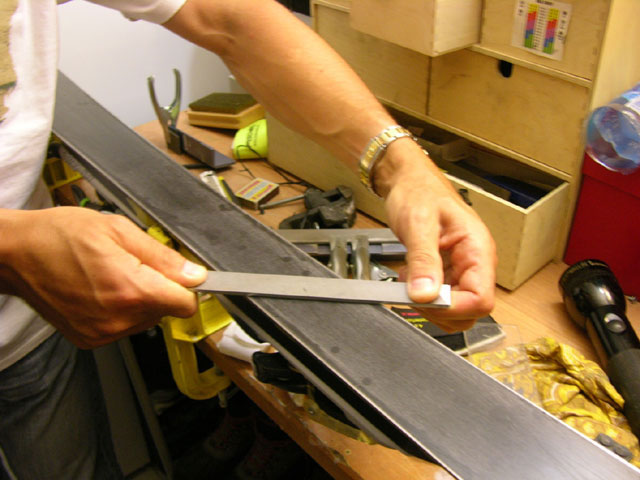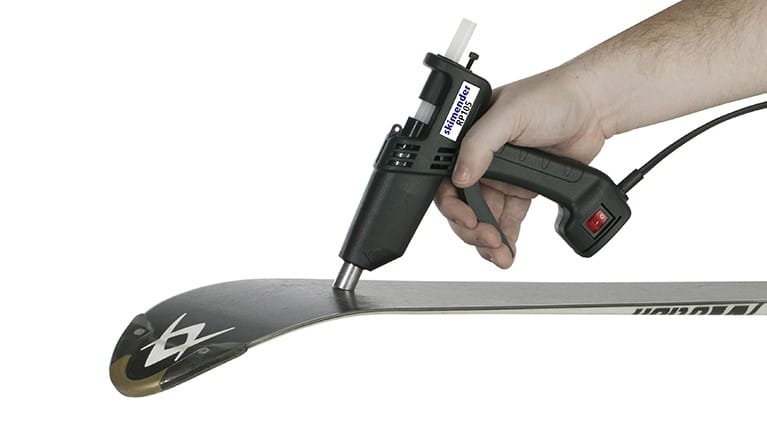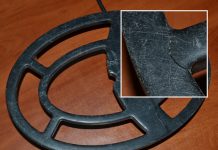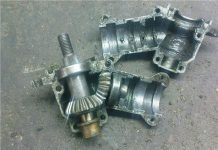In detail: do-it-yourself ski sliding surface repair from a real master for my.housecope.com.
Early winter. Making amazing turns and reveling in your courage, suddenly you hear a terrible crunch under your feet. Just don't panic; Removing a stone dent in your skis or snowboard is very easy with your own hands.
First of all, inspect the damage: what is broken and how serious?
Then follow the doctor's advice: "If you have a headache, take aspirin, but if you break your arm, do not operate on yourself."
So, you have only a dent on the sliding surface (slipper). Examine her carefully. If the dent is small or medium in depth and does not touch the edge, then you can repair it yourself. In case of more serious damage, contact the workshop. Minor damage (less than ½ mm deep) can simply be ignored.
If you decide to repair the damage yourself, then read on.
Necessary tools and materials.
- Vise
- Cleaner (or alcohol based material)
- Metal scraper (trowel type)
- Polyethylene repair plug P-Tex
- Propane torch or household candle
- Razor blade
- Sandpaper
Ski preparation
- Turn the skis with the skid up and secure the vise in the middle.
- Examine the damage. If there are strands of base material around the hole, cut them out carefully with a razor blade.
- Use a metal scraper to remove excess wax.
- If the dent is large, clean it from the inside with sandpaper.
- Rinse with cleaner and scrub with a small wire brush to remove any remaining dirt. Let the skis dry (20 minutes to an hour).
| Video (click to play). |
Dent filling
- Use a propane torch or lighter to light the P-Tex candle from one end.
- Wait for it to light up (this may take a couple of minutes). Black soot flakes may appear on the burning end. If they get on the slippery, the polyethylene may not weld well. Remove them carefully with a metal scraper. If the flame is small and blue instead of yellow, then there will be no soot.
- Bring a melting P-Tex candle to the damaged area. Drip the damage so that the drops flow from the edges to the middle of the dent. Fill it up as the P-Tex will shrink as it cools.
- Repeat this operation if necessary. Extinguish the flame.
- Refrigerate P-Tex for 15 minutes.
- Take a sharp metal scraper that is bent at a 90° angle and hold it at a 45° angle. Use small, jerky strokes to remove excess material from the base of the ski or snowboard. Move in the direction that is most convenient for you.
- Wrap the bar with sandpaper and sand the surface completely.
Do-it-yourself lubrication, sharpening, repair of alpine skis is real. In the article, we will share our experience on how to set up the process at home, what tools and materials to use and where to buy them.
Self-care for mountain skis - lubrication, sharpening, repair - for ordinary skiers seems to be a difficult task. We are frightened by the many different tools, noisy machines and splashes of sparks that we see in ski service centers.
Reichmann machine - repair and maintenance of alpine skis
However, getting your skis in order with your own hands is not as difficult as it might seem when you look at this chilling sight. This requires a little knowledge, as well as a set of tools and materials. And then the necessary skills will appear.
Why lubricate, sharpen and repair skis yourself? And in order not to run to the service center because of every little thing, wasting precious time and money. And the service center can be very far away, especially if you ride off-piste.
Yes, we ourselves can apply the right lubrication according to the weather, repair “holes” in the sliding surface and perform general pre-season maintenance.
Again, who doesn't like to mess with their skis, especially at the beginning of the season! We cherish them and cherish them as the most precious things to our hearts.
Today, the bathyscaphe descends to the depths, where materials and tools for ski care are hidden from our eyes. Do you feel how the cool sea breeze brings a slight smell of hot paraffin? If not, buy drops, you have a clear runny nose. Sneeze and breathe in all the salt of our vast ski ocean!
In any case, take your places! The captain is already impatiently biting the helm.
So, in the article we will talk about the simplest manipulations with skis. More complex repairs - broken bindings, torn edges - are best done in special workshops, which, as a rule, exist at every decent ski and boarder rental.
That's how they go, right? Of course they go, but they can go better, and much more. Everything is relative.
The two most important factors that help to get more pleasure from skiing are sharp edges and a perfectly sliding bottom surface of the skis (popularly called "slipper", "slipper"). And the drier the sliding surface, the more scratches on it and the duller the edges, the worse for us.
It takes much more effort to turn on running skis than to control well-sharpened and oiled skis. If you don't believe me, don't, but the time will come when you will understand what we have been talking about. Then appreciate the amazing feeling of sliding and tenacity that are inherent in well-groomed skis!
There are two options for ski care: you either take them regularly to a service shop and pay for MOT (maintenance), or spend a certain amount of money on ointments and tools at a time, and then save your hard-earned money and put your skis in order yourself.
The first option is simple and dull. The second one is informative and makes life more interesting, which will be discussed below.
Well, here we come to the most important thing - the stages of maintaining our skis, which consists of 5 steps:
- Preparation and cleaning.
- Sliding surface repair.
- Edge sharpening.
- Cleaning and lubricating the sliding surface.
- Polishing of the sliding surface.
If the skis have not been put in order for a long time or have been intensively used, it may be necessary to grind the sliding surface on the machine (for this, you will still need to go to the workshop). And then start working on them yourself. Find a table at home, an office one will do, because signing contracts is no more important than skiing in the mountains, right?
To fix skis on a household table, you will need the following fasteners:
Mounting skis on a household table
For example, a set of Toko brand vices in the Kant store costs about 17,000 rubles.
Ideally, you need a special workbench with a vise, but you will get it later, when you realize the joy of personal ski care. Now lift your ski feet, fix them with an elastic band (as in the picture above) and wipe the skis so that they are clean and dry.
Wipe a heavily soiled surface with a special cloth, such as fiberlen - it does not leave a lint that interferes with the work.
Lint-free special Fiberlene fabric
The easiest way to fix scratches on the base is to use P-Tex plastic candles. If you do this regularly, and there are several pairs of skis in the family, it is better to purchase a special thermal gun (although it is not easy to find one in Russia).
Thermal gun for repairing skis and snowboards
If from case to case, burying deep scratches with molten plastic will do.
Here is the sequence of work:
- Clean the work area with a wash;
- Cut off the peeled plastic around the “wound” with a sharp knife;
- Drop it with a melted P-Tex candle;
- Let cool to room temperature;
- Carefully cut off excess plastic until a surface with the same level is obtained;
- Sand the repaired area with fine sanding paper.
Important: any repair of the sliding surface can only be started after the skis / snowboard are well dried.
Always use protective gloves when sharpening edges to avoid cuts. Even if you see a bare hand in the picture below, it's just a promotional photo.
Ski edge sharpening
Clamp the skis in a vise as shown. Using a special file (file) and a guide corner with a clip or a special “cantor cutter”, sharpen the edges with smooth movements along the entire length of the ski.
Use short, overlapping file passes, gradually lengthening them. Clean the file of chips with a wire brush after every few strokes.
Repeat these steps on both edges. The direction of sharpening does not matter. Don't press too hard, let the sharp file do the job.
For greater clarity, I found an informative video on the Internet on sharpening edges at home. For those who are interested, take a look.
Rotate the ski in the vise so that the sliding surface is facing up. Scrape off the old paraffin and dirt with a plastic scraper. For best results, use a "hot scrape": heat up the paraffin wax with a flat iron and scrape off the skis of the plastic cycle (in a pinch, you can use a CD box) while the paraffin wax is still warm.
If the paraffin is heavily soiled, use an iron to apply a layer of "base" paraffin, and then scrape it off - this way you can better clean the base.
Scrape the old paraffin off your skis
You can lubricate the skis with an iron or use a ready-made lubricant that is applied to cold skis. Either way prevents the sliding surface from drying out, reduces friction, and helps the projectiles glide better.
Lubricated skis are easier to control. Hot wax and iron provide better lubrication because the wax penetrates deeper into the pores of the base material and lasts longer.
Applying paraffin to a sliding surface with an iron
You can also use ready-made grease - it is easy to use, but it does not protect the slipper for so long and provides good glide. This option is ideal for quick lubrication in the field when the hot method is not available.
Both lubrication options - both “for ironing” and “for cold” - are available in two types: for any snow temperature (universal ointment) and for specific temperature conditions (special lubricants).
Universal options will work effectively in most cases, but for a narrow temperature range it is better to use special lubricants and paraffins, they are more effective than universal ones. The result - the skis will glide faster, we spend less energy.
The more often the skis are hot treated, the better the sliding surface will absorb the lubricant. So, ideally, you need to turn on the iron after each ride. It is no coincidence that athletes lubricate their skis before each training session, not to mention competitions.
Well, it’s better for non-athletes to use the hot method before going to the mountains, and after each ride, lubricate with a universal lubricant designed for cold application.
After you have finished processing your skis, let them cool to room temperature.
Using a sharp plastic scraper, remove any excess wax. What remains in the pores of the material is quite enough for excellent ski glide.
Then, using a horsehair or nylon brush, buff the base well with strong pressure movements from the toe to the heel of the ski.
Repair candles for Toko skis
So, now we know how to take care of our skis (and boards) - how to sharpen the edges, repair and lubricate the base. At the end, here is a list of what you will need to work from home:
- Repair plastic P-Tex.
- Fibertex and remover for old grease.
- A special file and a corner with a clip or a cantorez.
- Plastic cycle (scraper).
- Stiff horsehair or nylon brush.
- sanding paper.
- Universal paraffin.
Manufacturers of materials and tools for ski maintenance:
All manufacturers are worthy, besides, the sites of all three have been translated into Russian. By clicking on the links, you will find a lot of useful information: what other tools are there, where you can buy them, how much they cost.
By the way, you will probably find an old iron with a temperature regulator, a lighter and a knife on the farm, and buy a brush for cleaning a file and work gloves where it is convenient.
Once again I enjoyed the fact that I wrote this work. I hope that it will be useful to you. Leave comments, requests and complaints, I will be happy to answer any question. Thanks to my friends who filled in the gaps in my experience and knowledge.
Let's float... no, one second...
If the article was useful, and you liked the bathyscaphe, then subscribe to new articles and get ski benefits straight to your inbox (no spam!).
- is it possible to ski / snowboard immediately after purchase - even if it is impossible, but I really want to. Of course you can!
- do i need to sharpen the edges? – to learn push-up turns – no!
- how much it is necessary to remove the transport (preservation) grease? - the first five descents will free you from this heavy care.
- Go to the catalog “Alpine skiing”
- Go to the catalog “Ski boots”
- Go to the catalog “Ski poles”
- Go to the catalog “Ski and snowboard helmets”
- Go to the catalog “Ski masks”
- Go to the catalog “Ski backpacks”
- Go to the catalog “Ski clothing”
SPORT-MARATHON: THE LARGEST TOURIST AND SKI STORE IN MOSCOW. SAIKINA 4
You might think that Sport-Marathon is just another sports and tourist store in Moscow, and you will be wrong. We do sell clothes and equipment for skiing and snowboarding, as well as tents, sleeping bags, backpacks and other goods for outdoor activities. But that's where our similarities to other stores end. We are different!
Working on the top equipment market for more than ten years, our company managers have accumulated a huge amount of knowledge in order to try to make the best ski and outdoor store in Moscow! And believe me, these are not empty words. Personal passion for tourism and skiing, hundreds of hours at exhibitions and seminars and many years of cooperation with the best distribution companies allow us to present a truly outstanding range.
In addition to the excellent assortment, we have tried to make our store not only a pleasant and convenient place for shopping, but a real Club and a favorite meeting place for all lovers of tourism, skiing and outdoor activities in general. Therefore, we made a new renovation, ordered special, individual retail equipment, suffered for a long time, choosing a convenient and pleasant light, and even developed what we think is the best loyalty system for the most active customers. We even found a place for a cafeteria where you can have a bite to eat during the tedious but enjoyable shopping!
Early winter. Making amazing turns and reveling in your courage, suddenly you hear a terrible crunch under your feet. Just don't panic; Removing a stone dent in your skis or snowboard is very easy with your own hands.
First of all, inspect the damage: what is broken and how serious?
Then follow the doctor's advice: "If you have a headache, take aspirin, but if you break your arm, do not operate on yourself."
So, you have only a dent on the sliding surface (slipper). Examine her carefully. If the dent is small or medium in depth and does not touch the edge, then you can repair it yourself. In case of more serious damage, contact the workshop. Minor damage (less than ½ mm deep) can simply be ignored.
If you decide to repair the damage yourself, then read on.
Necessary tools and materials.
- Vise
- Cleaner (or alcohol based material)
- Metal scraper (trowel type)
- Polyethylene repair plug P-Tex
- Propane torch or household candle
- Razor blade
- Sandpaper
Ski preparation
- Turn the skis with the skid up and secure the vise in the middle.
- Examine the damage. If there are strands of base material around the hole, cut them out carefully with a razor blade.
- Use a metal scraper to remove excess wax.
- If the dent is large, clean it from the inside with sandpaper.
- Rinse with cleaner and scrub with a small wire brush to remove any remaining dirt. Let the skis dry (20 minutes to an hour).
Dent filling
- Use a propane torch or lighter to light the P-Tex candle from one end.
- Wait for it to light up (this may take a couple of minutes). Black soot flakes may appear on the burning end. If they get on the slippery, the polyethylene may not weld well. Remove them carefully with a metal scraper. If the flame is small and blue instead of yellow, then there will be no soot.
- Bring a melting P-Tex candle to the damaged area. Drip the damage so that the drops flow from the edges to the middle of the dent. Fill it up as the P-Tex will shrink as it cools.
- Repeat this operation if necessary. Extinguish the flame.
- Refrigerate P-Tex for 15 minutes.
- Take a sharp metal scraper that is bent at a 90° angle and hold it at a 45° angle. Use small, jerky strokes to remove excess material from the base of the ski or snowboard. Move in the direction that is most convenient for you.
- Wrap the bar with sandpaper and sand the surface completely.
In the process of writing arcs on slopes of various profiles and qualities, alpine skis become unusable. Therefore, the main purpose of this message is to consider ways to distance this sad moment in every sense.
Snow crystals act as a good abrasive (skin). As a result, the sliding surface of rolled skis acquires a whitish color familiar to many. It is clear that this does not reduce friction and the process develops. You can counter this if periodically, depending on the intensity of skiing, wax the skis. For a skier who spends 3 to 6 hours a week on the snow, the frequency is approximately 1 time per month.
Skis are cleaned with a swab dipped in gasoline or acetone (preferably both in the specified sequence). Then, after a short drying, the sliding surface of the ski is greasyly rubbed with paraffin-primer (you can also use a candle in the absence of a set of ointments), then the surface is smoothed with a heated iron (tie irons are especially convenient). Heated paraffin fills in surface defects, and its excess is removed with a cycle, that is, with a flat steel plate (a wide spatula is good, for example). The surface is finally polished with cork. Then a long plastic bag is put on top and bottom of the skis and you are ready to start. The bags are put on so that during carrying, debris (dust, sand) that gets between the skis does not scratch the surface. The need for this is clearly visible before processing - note that most of all the base is damaged in 20 cm areas at the toe and heel.
Therefore, it is necessary to fix the ski in a vise and, using suitable files, grind the ski from the side of the base until the surface is absolutely smooth. Checking with the same ruler. The surface must also be smoothed. A cantorez is suitable for this purpose. You just need to remove the guide plate from it.
If defects remain on the surface - yesterday they traveled over stones, then they must be repaired using known methods. I just want to add that heating with an iron requires special care (the consequences are described), so it is safer to use a 75-100W soldering iron. And yet, it is better to press the welded polyethylene with a polished wooden block, because, due to low thermal conductivity, it allows you to press still soft polyethylene. Don't overdo it with pressure - one novice ski-master squeezed the flex area on the tip of the ski so much that it became, as it were, part of a polygon.
In conclusion, a few words about kants. Do not be lazy with a velvet file to grind off small defects that occur after almost every ride. Your sliding will become much easier. After all, the ski, of course, must be waxed.
Rental equipment has one indisputable advantage - you do not have to take care of it. They just skated, handed over the skis to the rental worker and forgot. Preparing skis for the season in this case - the "headache" of the servicemen of the ski resort.
But, if you have already acquired your own equipment, you will have to take on the entire “burden of responsibility”. As a rule, the preparation of alpine skiing for the season begins immediately after the last skiing period. And after each training session, it will not be superfluous to service your skis.
Before climbing the slope at the beginning of the season, I usually check how sharp the edges of my skis are. This is done quite simply. First of all, a visual inspection. No notches on the edges - everything is in order. Further, you can scrape the edge with your fingernail and, if chips form on the nail, then the edges are still quite suitable for riding. Otherwise, the edges will have to be sharpened. Probably, this is the main moment in the preparation of skiing for the season.
I do not advise sliding on blunt edges, because, firstly, it is not safe, and secondly, it will be extremely difficult to perform turns on a hard slope.
You can sharpen the edges during the preparation of skiing for the season on your own or seek help from a service. Edges on skis are sharpened depending on the level of training of the skier. For beginners, a sharpening angle close to 90 degrees is suitable. Athletes sharpen at a sharper angle, but in this case, the edges dull faster.
You can read more about ski edge sharpening here.
Preparing skis for the season does not do without checking the fasteners. It is necessary to check that the fasteners do not hang out, do not have mechanical damage that could have formed either at the end of the previous season or during storage.
Next, set the required value for the actuation force of the bindings, depending on your weight and level of training.
How to do it? Nothing complicated! You can find out more about adjusting ski bindings here.
To complete the preparation of skiing for the season, look at the sliding surface of your skis for the preservation of its properties. The slipper should have a uniform black color. In the event that a grayish or white coating is observed along the edges, along the edges, it is better to treat the skis with special paraffin and ointments that improve glide with ironing.
To begin with, we remove pollution from the surface of skis that could have formed during skiing. This can be done with a damp cloth or with the help of special cleaning liquids.
On the fasteners, weaken the forces to the minimum values so that the springs are not constantly in a compressed state (let them rest).
To avoid drying of the sliding surface and the formation of a white coating on it, it is better to treat the base (sliding base) and edges with paraffin.
We store skis vertically and away from heating devices. It is advisable to open the cover a little, providing air access to the skis, or even store the skis outside the cover or wardrobe trunk.
After skiing for a day on skis, before stuffing them into the car, it is advisable to go over the skis with a sweeping brush, cleaning them of adhering snow, and upon arrival home, put them in a vertical position so that the water is completely glass.
Then we wipe the skis with a rag and start dreaming about future snowy peaks!
Thus, the preparation of skiing for the season is not particularly difficult, you just need to love your skis a little and they will serve us faithfully for a long time.
When buying skis, we always hope that good glide will be maintained throughout the entire service life. However, a year or two passes and the skis gradually lose their properties. At a positive temperature, snow begins to stick under the block, and with a good minus, the skis don’t “go” at all. During operation, the sliding surface is inevitably damaged. Deep and small scratches appear on it, it is enough to drive along a branch and a trace may remain on the plastic. All these damages, of course, affect the quality of sliding and, as a result, the speed of movement. To avoid such troubles, it is enough to regularly lubricate and, if necessary, scrape the skis.
If you didn’t do it in time, but instead of buying new skis you decided to put the old ones in order, then this article is for you. Where to begin? First of all, with tools. The minimum ski preparation kit consists of an acrylic scraper, an iron, a combination hand brush (nylon/bronze) and a rubbing (synthetic or cork). This is enough for the care of walking skis, if you have the opportunity to fix it with the help of improvised means when processing the ski.
For better preparation, you need a special table that allows you to firmly fix the ski. It is also desirable to have a metal scraper-cycle and repair plastic.
1. Fix the ski motionless with the sliding surface up. If necessary, remove the remnants of the old grease with a scraper, then using a scraper to remove a thin layer of oxidized plastic.
2. Thoroughly clean large scratches from dirt and fill with repair plastic (a plastic stick is set on fire from one side and the damaged area is poured from a distance of 1-2 cm). Then, after cooling, the excess plastic at the repair site is carefully removed with cycles, achieving a smooth, uniform surface.
3. Apply ground paraffin to the prepared sliding surface, heat it up with an iron and allow the paraffin to harden.
4. Remove paraffin with a scraper, treat the ski with brushes. Repeat the operation described in paragraphs 3-4 several times.
5. Apply paraffin, selected in accordance with weather conditions, to the sliding surface, warm it up with an iron and allow the paraffin to harden.
6. Remove paraffin with a scraper, treat the surface with brushes.
7. Repeat this procedure several times depending on the length of the distance from the snow condition. The longer the distance and the harder the snow, the more layers of paraffin are recommended to be applied to the ski.
8. After applying the last layer of paraffin, it is necessary to remove the paraffin with a scraper, remove its remnants with a nylon brush. Remove wax residues from the grooves of the structure with a steel brush with fine hair (1-2 passes without pressure), and then polish the sliding surface with a soft nylon brush.
Now your skis are ready for the season.
If you have any questions related to the preparation or selection of skis, L-BIKE specialists and service center employees will always provide the necessary assistance and advice.












